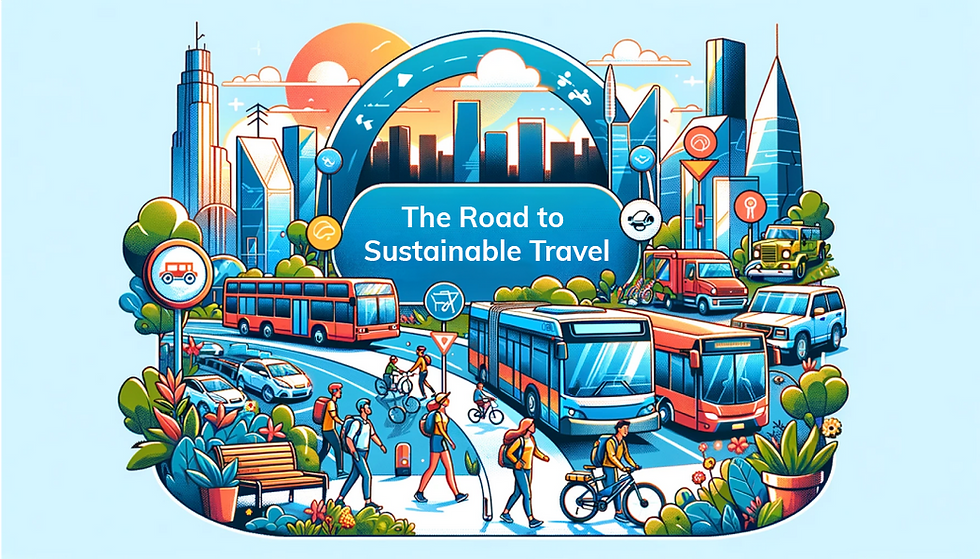Incentivizing Active and Shared Travel Pilot Program
- Grey Cheng
- Jul 16, 2024
- 3 min read
Updated: Nov 1, 2024

The Metropolitan Transportation Commission's recent pilot shows the value and potential of leveraging targeted, tailored incentives to influence drivers to put down the keys and adopt sustainable modes of travel. The pilot provided a successful blueprint for other agencies considering innovative approaches to traveler behavior change, and its findings support the recent strategic policies published by the Department of Transportation.
1. Introduction
The Metropolitan Transportation Commission's (MTC) Climate Initiatives Program, under Plan Bay Area 2050 (PBA 2050), aims to reduce greenhouse gas emissions by decreasing vehicle miles traveled (VMT). The Incentivizing Active and Shared Travel Pilot Program (the "Pilot") utilized behavioral economics and experimentation to understand and actively influence traveler behavior and promote sustainable mobility options.
2. Project Background and Challenges
Initiated in May 2021, Metropia and its partners The Behaviourist and Transportation Analytics commenced the Pilot, which sought to comprehend travel behavior in the post-COVID era. However, an unexpected surge in COVID-19 cases and subsequent work-from-home policies significantly disrupted the project's planned execution. These challenges impacted participant recruitment and retention, prompting MTC and the research team to adapt their methods. Despite these obstacles, over 200 participants were successfully recruited within budget.
3. Objectives and Approach
The Pilot aimed to identify "nudgeable drivers"—those open to behavior change—and evaluate interventions to shift their travel choices toward sustainable modes. The GoEzy mobile app was used as the primary platform for onboarding, coaching, delivering interventions, and collecting data. Random Control Trials (RCT) were designed to study the effects of various monetary and non-monetary behavioral nudges on both one-off and habitual trips. By combining quantitative and qualitative analyses with socio-demographic data, the study gained insights into users' preferred modes of transportation and their underlying travel behaviors.

4. Key Findings
1. Characteristics of Nudgeable Drivers

Older Working-Age Adults: Participants aged 37-56 were more receptive to behavioral interventions.
Multiple Mode Options: Those with access to various transportation modes responded positively to interventions.
Bicycle Owners: Drivers who owned bicycles were more inclined to adopt non-driving transportation modes.
Regional Variability: Participants from certain regions, notably San Francisco County and specific areas within Contra Costa and Santa Clara Counties, showed greater responsiveness.
Presenting a personalized attractive non-driving option is more likely to be adopted by the users than presenting a random option.
2. Travel Patterns of Nudgeable Trips
Shorter Travel Time and Distance: Incentives were more effective for shorter trips.
Walking for Trips Less Than 3 Miles: Participants were willing to switch to walking for short distances.
Cycling for Trips Less Than 10 Miles: Cycling was favored for moderate distances.
Weekday Responsiveness: Nudges were more effective during weekdays.
3. Effects of Messaging Strategies

Ineffective Blanket Public Transit Messages: General public transit information without specific, personalized details did not significantly change behavior.
"Do Not Drive" Messages: Noticeable effects in encouraging some drivers to consider non-driving modes when planning the trip.
Receptive Flexible Travelers: Those familiar with active and shared travel modes were more open to interventions.
4. Effects of Incentives

Effective Monetary Rewards: Incentives of $3-$5 encouraged the use of multiple modes.
Lower Rewards for Feasible Alternatives: Smaller incentives were effective when presenting the viable second-best travel option.
Rewards for Walking and Cycling: Monetary rewards increased adoption of non-driving modes.
Transit Incentives with Short Access Times: Incentives were effective for transit options with access times under 15 minutes.
5. Recommendations for Future Programs
The Pilot's findings offer valuable insights for developing targeted strategies to encourage the adoption of sustainable travel modes. Recommendations for scaling up the program include:
1. Targeted Recruitment
Mirror target audience segments after the related persona groups in marketing efforts
Implement geo-targeting techniques using Origin-Destination (OD) trip matrices to identify high trip volume areas with attractive second-best options.
Diversify outreach methods, including partnerships with local businesses and event organizers.
2. Mobility Platform Adoption
Utilize a mobility platform to onboard, retain, coach, educate, and deliver personalized messages and incentives.
If a mobility platform is not implemented, traditional methods such as mobile web-based activity logging can be used, though these have limitations.
3. Personalized and Dynamic Nudges
Use electronic surveys, SMS tracking, or QR code feedback systems for communication.
Employ behavior techniques like personalization, gamification, goal setting, and positive reinforcement to enhance engagement.
Focus on messaging that encourages walking and biking for short trips, leveraging the attractiveness of second-best options.
6. Conclusion
The Pilot's insights into nudgeable drivers and effective interventions can significantly enhance the cost-effectiveness of future travel demand management programs. By targeting resources towards individuals inclined to consider sustainable options, MTC can develop a more impactful and efficient approach to managing travel demand in the region. Personalized messaging and dynamic incentives are crucial in promoting the adoption of non-driving modes, contributing to the overarching goals of Plan Bay Area 2050.
Please see the complete MTC report to learn more about this pilot and its promising findings.